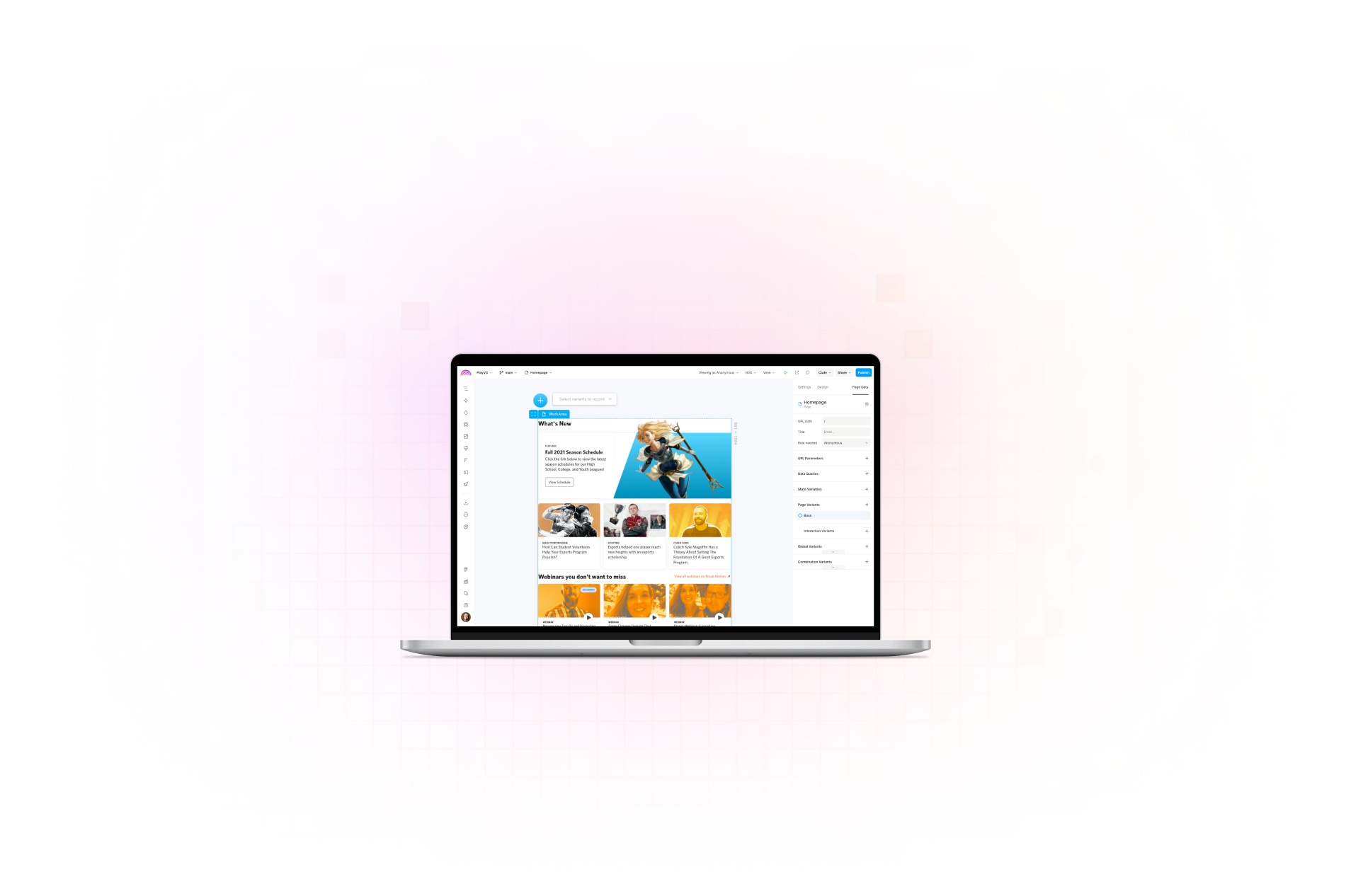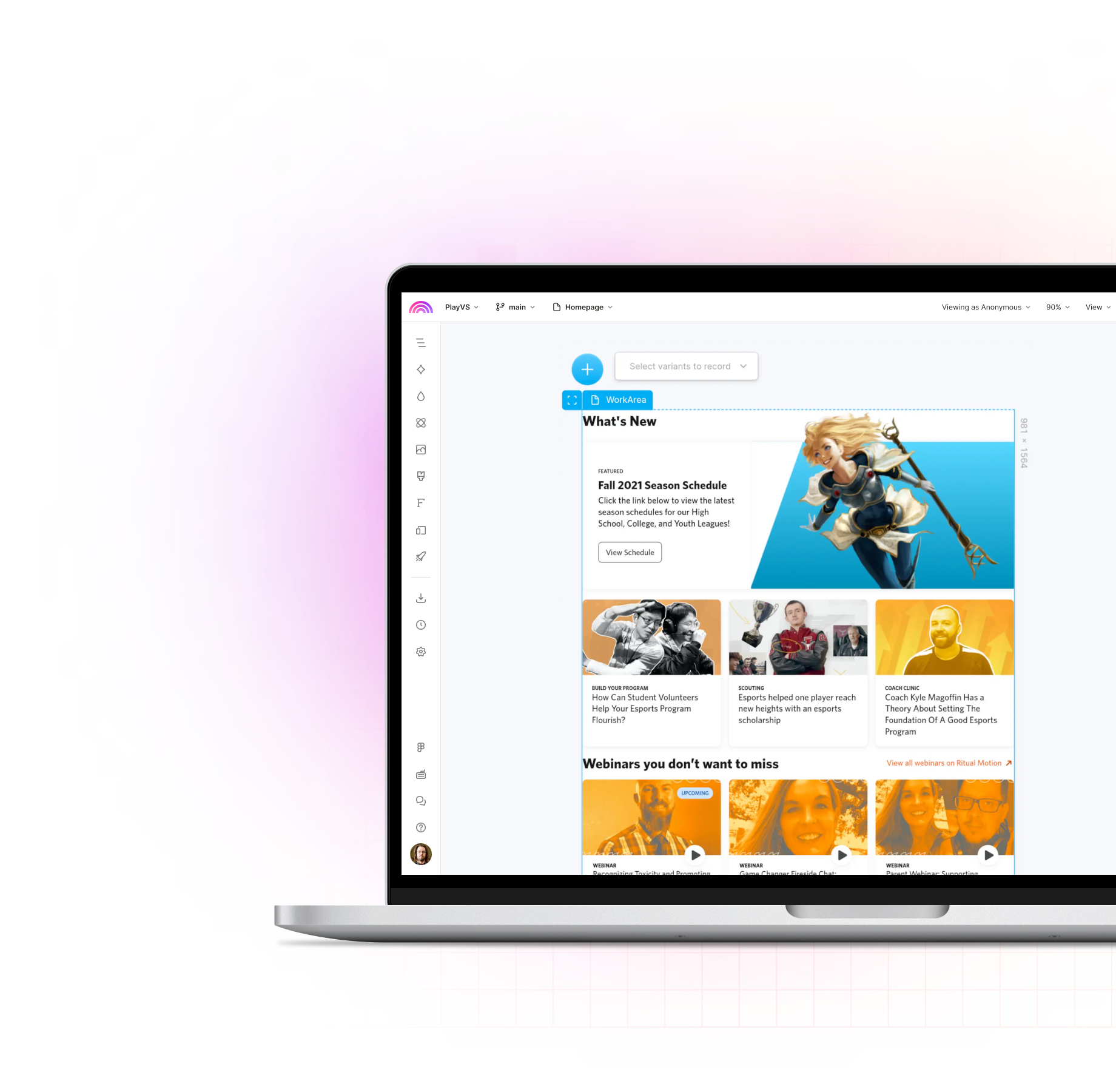
Rapidly iterating on the logged-in app experience without developers
PlayVS supports esports leagues around the country at the high school and collegiate level. Each season, they need to publish a lot of new design-rich content to their app. PlayVS needed a better solution for visual content to be shared across the application and marketing page.


Problem
PlayVS supports esports leagues around the country at the high school and collegiate level. Each season, they need to publish a lot of new design-rich content to their app. However, the typical engineering workflow of gathering requirements, engineering estimation, development, testing, code review, and release, meant that content updates were few and far between. Users frequently pointed to the stale content still being served by the app.
PlayVS needed a better solution for visual content like banners, referral pages, and featured tiles that would be shared across the application and marketing page.
Prior to Plasmic, PlayVS faced the following challenges:
- Only a fixed set of CMS layout templates and building blocks are supported. New features often call for very new and different user experiences.
- All the building blocks are implemented entirely in code by software engineers.
- All content changes, no matter how small, were bottlenecked by engineering capacity.
"Before Plasmic, we had coaches point to our 'News' area in the product and say 'This is what I call the section I never read.' The articles are from months ago! Old news is no news. We simply didn't have the time or resources to update this content regularly."

Nick Lesec
Goals
To accelerate experimentation, the team is focusing on the following key areas:
1
Democratize implementation
Enable non-developers, such as designers and marketers, to implement production components for beautiful responsive content layouts.
2
Reduce friction to update content
Enable the marketing team to directly deploy updates without going through manual engineering processes.
3
Enable incremental adoption
Work within the existing tech stack and allow teammates to start with limited surfaces, without requiring a full re-implementation or port of existing work.
4
A scalable approach
Allow many teams to build experiments in parallel without conflicting with each other, scaling with business needs.
"With Plasmic, I was able to quickly integrate on content templates with the design team. By sharing my screen and making changes in the Plasmic visual editor, we could toggle props and make adjustments in real time to get it exactly right."

David Lai
The Plasmic approach
Jonathan Bowell, the lead engineer manager charged with evaluating many different CMS options, performed a deep dive comparison of Plasmic to other tools.
The solution needed to be easy to use for non-developers, flexible enough to implement rich visual content, integrate easily with their existing code base, and perform well under performance stress tests. They also performed a thorough code audit of the libraries that will be added to production dependencies. Plasmic turned out to be the only solution that met all of their requirements.
With Plasmic, they found a solution that helps with:
- WYSIWYG page and component builder: Plasmic Studio is the only product that provides the necessary flexibility and freedom to implement designs as envisioned, while keeping it easy for anyone to visually create new pages and content. Plasmic ships to production with high design fidelity and speed.
- Blazingly fast, production-ready: PlayVS performs speed audits and a line-by-line code audit of Plasmic components. Plasmic has to be ready to use on their most trafficked pages.
- Seamless integration: Plasmic flexibly integrates into any codebase, making it easy to leverage existing pipelines and workflows. Hand-written and Plasmic-generated components are indistinguishable to the user.
- Team empowerment: Within a 30-minute training demo, non-developers were up and running, implementing their own content in Plasmic and deploying without a developer in the critical path. Today, the marketing team owns surfaces in production that normally would have been owned by engineering.
Use cases
Plasmic content has been deployed on the application dashboard, the team's most heavily-trafficked property. Plasmic makes it easy for anyone on the team to create and update rich experiences, giving teams outside of engineering the ability to ship high-impact content, like those used for promotions. By designing news content in Plasmic, these highlights can be easily updated as often as needed.
This is just the beginning for Plasmic at PlayVS. The team also redesigned their in-app referral page in Plasmic, allowing the team to rapidly experiment with different incentive programs.
Everyone, from designers to marketers to developers, is empowered to create a new experience. Plasmic also plugs into existing deployment and QA processes, so you can move fast with the guardrails you need. This increased velocity will help make PlayVS even more agile in this dynamic market.
"We did a thorough competitive analysis with comparable studio builders, but they were much more cumbersome to integrate into a code base, whereas it was 'boom it's there' with Plasmic.”

Nick Lesec